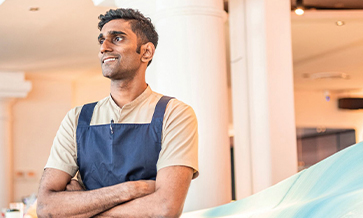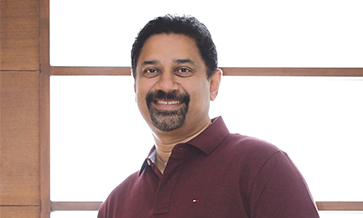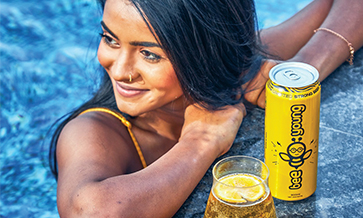MaximePulci is the youngest International Brand Ambassador for Remy Martin cognac. He has an MBA in Luxury Brand Management for food, wine and spirits. He was based in India from 2017 to 2018 as the Louis XIII Brand Ambassador, after which he is traveling around the world on their behalf. Consulting Editor for Brews&Spirits, VikramAchanta, caught up with him recently.
How do you differentiate Rémy Martin from other cognac brands?
In the region of Cognac, there are six areas (called crus), each with its own unique terroir made from different combinations of soil and climate. At Rémy Martin, our eaux-de-vie (distilled wine spirits; literally ‘waters of life’) come exclusively from the Grande Champagne and Petite Champagne crus, both terroirs that yield spirits with exceptional aging potential.
A cognac can only be called Cognac Fine Champagne if it is made exclusively from the eaux-de-vie of Grande Champagne and Petite Champagne, of which at least half must come from Grande Champagne.
You may find it surprising to find the word ‘champagne’ used here. When we use it in regard to cognac we are talking about the soil and the terroir. Champagne is derived from the Latin word campagna which refers to the countryside and its rolling chalky hills.
Chalk is very important within the world of Rémy Martin and plays a huge role in the growing of high-quality grapes. It reflects the light and retains moisture in dry weather. The result is exceptionally aromatic grapes and eaux-de-vie with superior aging potential.
Thanks to André Renaud, in 1948 Rémy Martin made a choice to exclusively specialise in Cognac Fine Champagne, which became a part of the brand’s DNA.
Why does Rémy Martin start at the VSOP level and not VS like most cognac houses?
Cognac VS is made from a blend of eaux-de-vie, with the youngest one aged for a minimum of 2 years. The youngest eau-de-vie in cognac VSOP is aged for at least 4 years. Rémy Martin is made 100% from Cognac Fine Champagne, an area that produces eaux-de-vie with exceptional aging potential.
The longer the eaux-de-vie age, the more the exceptional aromas of our cognacs are revealed. Hence the brand’s choice is to start the product range from VSOP level.
Do you distill most of the eaux-de-vie yourself or do you source it from outside?
The year 1724 marked the beginning of Rémy Martin, the only major cognac house to have been founded by a wine grower. In 1965, Rémy Martin also created the first ever wine growing cooperative in the Cognac region, the Alliance Fine Champagne.
Today, 900 Grande Champagne and Petite Champagne wine growers provide Rémy Martin with a selection of quality eaux-de-vie in an equitable partnership.
What is the difference between the roles of Cellar Master and Master Distiller?
The Master Distiller distils our own eaux-de-vie and also acts as a consultant to external distillers that are members of the Alliance Fine Champagne. Baptiste Loiseau, the Cellar Master of the House Rémy Martin, is the guardian of the heritage of the house.
Baptiste is a part of the tasting committee that selects the eaux-de-vie, and leads the blending process to create Rémy Martin’s signature cognacs.
What kind of wood do you age the eau-de-vie in? There is a trend amongst some Cognac houses to use different kinds of wood to give a finish to the blend. Is this a practice also being adopted by Remy Martin?
Rémy Martin matures the eaux-de-vie in barrels made exclusively from French Limousin oak, which contributes to the aromatic development of the blend. We have new casks (5 years), seasoned casks (5-15 years) and old casks (more than 15 years).
We don’t use any other type of wood to mature or finish our spirits. We believe this is the right way and the classic way to age our cognac. We want things to be done as they were done before.
In the maturation of cognac, how important is the factor of the cellar?
The cellar plays a very strong role in the development of eaux-de-vie. Each cellar has its own signature, which helps to release certain aromas and notes, depending on the level of humidity, temperature, and depth of the cellar.
In a country like India, where duties and taxes are high, how do you build a culture for fine spirits like cognac?
The first thing to build a culture for fine spirits like cognac is to know the product very well. Knowledge and training are crucial for the staff to be able to tell the story of the brand, and how to enjoy and appreciate its products.
There are several ways to enjoy cognac; there is no one particular way. Some customers would like to drink a cognac cocktail with VSOP; others are interested in tasting a glass of XO on the neat.
What would be your advice to Indian hoteliers and restaurants?
The best way to build culture is also for brands to create experiences, as experience is important to create memories. For example, the Rémy Martin Opulence Revealed table is an educative way to experience the XO cognac with food pairings to bring out the flavors and aromas of each expression.
All around the world we see cognac brands appealing to a younger audience. What strategy is Rémy Martin adopting?
It is really all a question of education and experience – by exposing clients to the spirit and sharing new ways of experiencing cognac we invite them to become cognac lovers.
Bartenders and mixologists are very important for us and we focus a lot of time and attention in terms of sharing knowledge of the brand and confidence in using it behind the bar. Our job is to turn them into ambassadors of the brand.
What’s your favourite expression of Rémy Martin?
I don’t have a favourite because each expression is so different. You can enjoy them in very different ways. It’s not about the drink; it’s about the experience and the moment. Every cognac in our portfolio brings a different experience to me depending on my mood.













